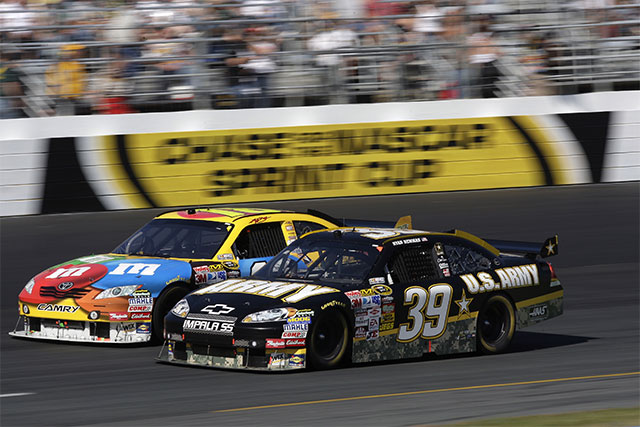When discussing motor racing, NASCAR stands out for its intense competition and exciting high-speed action. A recurring query that often emerges among devoted followers and casual motorsport enthusiasts alike is: What is the top speed of NASCAR?
Across the seven decades of the sport’s existence, NASCAR speeds have experienced a gradual rise. In the 1980s, they surged past the 200-mile-per-hour threshold, only to recede following the implementation of Restrictor Plates and unsettling incidents like Bill Elliot’s crash in 1987. Presently, it seems that speeds are once again trending upward. While not yet reclaiming the 213-mile-per-hour or 240-mile-per-hour high points of that era, the 200-mile-per-hour benchmark is yet again within close range.
The velocity at which a NASCAR race car travels hinges on the nature and extent of the track. On Superspeedways, NASCAR race cars have managed to achieve speeds of 212 mph and an unregulated 240 mph. Conversely, the average velocities range between 70 to 80 mph on road courses characterized by numerous turns.
Notably, on Utah’s salt flats, NASCAR once achieved a remarkable speed of 271 mph in a straight-line endeavor. So, the top speed of Nascar is 271 mph.
Table of Contents
Knowing the Top Speed of NASCAR

Find out the top speed of NASCAR at different race tracks around the world, including short, intermediate, and superspeedway tracks.
Nascar Speed
NASCAR vehicles display remarkable speeds, as the fastest cars achieve approximately 200 mph these days.
Such velocities result from the synergy of potent engines, featherweight components, and meticulous aerodynamic blueprints. Yet, it’s vital to recall that myriad elements impact a car’s ultimate velocity, encompassing engine dimensions, tire traction, and the track’s state.
Speedway
One of the primary factors influencing NASCAR speeds is the structure of the racetrack itself. Circular tracks come in different types: brief, intermediate, and superspeedways. The lengths of these tracks can range from half a mile to two and a half miles, and this configuration significantly affects the maximum speeds achievable by cars.
Consider, for example, Daytona International Speedway, a 2.5-mile track with steep banks, where NASCAR automobiles consistently attain speeds approaching 200 mph.
Conversely, on more compact and less inclined circuits like Martinsville Speedway, which spans just 0.526 miles, average speeds usually hover around 100 mph.
Miles per Hour
For a deeper grasp of the speed of NASCAR vehicles, explore these average velocities across different speedway categories:
- Small Tracks: 90 – 110 mph
- Middle Range Tracks: 150 – 170 mph
- Large Superspeedways: 180 – 200 mph
Beyond mere top speeds, NASCAR racers must factor in their average pace since upholding a reliably swift speed is vital for triumph on the circuit. Given these substantial speeds, adept steering and unwavering focus play a crucial role in evading mishaps and clinching a win. You must learn how to prepare for a track day.
What is the Fastest NASCAR Track?
While most individuals link the Talladega Superspeedway with top speeds in NASCAR, the Michigan International Speedway has gained recognition as the swiftest, courtesy of Australian driver Marcos Ambrose’s skillful maneuvers.
In the middle of 2012, Ambrose significantly outpaced the former track speed record, achieving an average lap speed of 203.241 mph, surpassing it by a remarkable 9 mph. Nevertheless, this record was later surpassed by Jeff Gordon in 2014.
Indeed, before that pivotal day in Michigan, the preceding record for the fastest lap speed stood at the Texas Motor Speedway. This feat was accomplished in 2006 by Brian Vickers and remained unchallenged until Ambrose and his compatriots made their mark at the Michigan circuit in June 2012.
It’s quite intriguing that Ambrose might have emerged as the top record-breaker on that occasion, but he wasn’t alone. On that very significant day in Michigan, 38 of the other drivers shattered the identical Texas record.
To maintain fairness, this circumstance only applies when we consider the new element of restrictor plates. The rationale behind people linking tracks like Talladega with remarkable speeds is that prior to the introduction of restrictor plates, it also hosted the ultimate speed record established by Bill Elliott in 1987, registering an impressive 212.809 mph. Nevertheless, as noted earlier, it also served as the backdrop for numerous significant incidents, all adding to the organization’s conviction that restrictor plates were a necessity.
What is the fastest NASCAR speed and tracks?
Fastest Speed of NASCAR
In 1987, Bill Elliott set an unmatched record, reaching a speed of 212.809 mph during a NASCAR qualifying run at Talladega Superspeedway.
Following that era, changes were introduced involving restrictor plates, which curbed engine horsepower and subsequently decreased the maximum race speeds.
Nevertheless, modern technological progress has enabled racers to approach those remarkable speeds once more.
Fastest NASCAR Race Cars
Various race cars have garnered attention for their speed and performance throughout the rich history of NASCAR. A selection of these noteworthy vehicles includes:
- The 1987 Ford Thunderbird: Skillfully piloted by Bill Elliott, this automobile lays claim to the record for the highest velocity ever achieved in NASCAR’s world. Its propulsive force originates from a potent V8 engine, enabling it to reach an amazing top speed exceeding 212 mph.
- The 2007 Chevrolet Monte Carlo SS: Under the skillful guidance of Jeff Gordon, this car etched its name in history by establishing a new track record at Talladega. It reached an awe-inspiring speed of 201.293 mph during a routine practice run.
- The 2018 Ford Fusion: Commanded by the capable hands of Brad Keselowski, this vehicle notched an impressive achievement by attaining a top speed of 211.413 mph in the midst of a testing session held at the Michigan International Speedway.
Fastest NASCAR Drivers
- On June 9, 2004, Rusty Wallace achieved a speed of 216.309 mph at Talladega Superspeedway, although it wasn’t in an official NASCAR race.
- Bill Elliott set a record of 212.809 mph at Talladega Superspeedway on April 30, 1987.
- On February 9, 1987, Bill Elliott reached a speed of 210.364 mph at Daytona International Speedway.
How Rapidly Do NASCAR Vehicles Move on Short Tracks?
NASCAR’s short tracks measure a mile or less in length. Among these, the most compact tracks by far are Martinsville and Bristol, both spanning roughly half a mile. Our velocity metrics below come from Martinsville, the smaller of the two.
- Maximum NASCAR Speeds: Presently, the swiftest a NASCAR has achieved on a short track is around 100 miles per hour. It primarily occurs during qualifying laps with minimal track congestion. Once an actual race takes off, factoring in pit stops and caution periods, the average speed tends to level around 80 to 85 miles per hour.
- Factors Influencing NASCAR Speed: Short tracks exhibit briefer straights and tighter bends compared to other oval circuits. Unlike other open-wheel vehicles, NASCARs lack rapid acceleration, elongating the time required to attain high speeds. Consequently, their performance on shorter tracks is restricted compared to more expansive ovals with wider turns. Negotiating tighter corners mandates more frequent and forceful braking, substantially curtailing overall speeds.
What’s the Speed of a Nascar on a One-Mile Oval?
While 1.5-mile tracks take the spotlight during the NASCAR season, it’s crucial to reveal the significance of one-mile tracks in emphasizing the role of length in NASCAR speeds. Tracks like Dover, spanning a mile, might be seen as relatively short, yet the increased distance significantly amplifies both the top and average race velocities, undeniably propelling NASCAR into higher gear on these stretches.
- Top Speeds in NASCAR: The Monster Mile at Dover has witnessed speeds exceeding 166 miles per hour, underlining how track length influences NASCAR velocity.
- The Logic Behind NASCAR Speed: Beyond the 166 mph recorded at mile-long tracks like Dover, NASCAR race cars exploit track length to gather momentum, benefiting from broader corners that conserve speed. Moreover, the added length can strategically disperse the field, particularly between caution periods and stages.
What is the top speed reached by a NASCAR vehicle on a Superspeedway?
Superspeedways stand as the lengthiest oval tracks within NASCAR, with Daytona and Talladega gaining notable prominence, the former being the largest NASCAR race and the latter boasting the longest track. These tracks extend beyond 2.5 miles, enabling cars to achieve and sustain incredibly high speeds.
- NASCAR Speed Facts: Talladega stands as the site of the quickest authenticated run ever recorded in NASCAR’s history. Bill Elliot (father of Chase Elliot) clocked a blazing lap of 212.8 miles per hour during qualifying in 1987. That race weekend witnessed significant wrecks that marked the onset of the restrictor plate era. On an average scale, cars can maintain a continuous velocity of 188 miles per hour.
- Grounds Behind NASCAR’s Speed: Both Daytona and Talladega sport lengthy straights, steep banking, expansive turns, and the potential for drafting (where cars exploit air dynamics to propel each other at heightened speeds). This dynamic fosters not only the likelihood of crashes but also provides NASCAR racing vehicles the avenue to attain their remarkable speeds.
How quick is the straight-line speed of a NASCAR race car?
During an acceleration challenge, a NASCAR vehicle lags behind both an F1 and an IndyCar open-wheel racing car. These automobiles are engineered for swift acceleration and adept maneuvering, particularly the F1 race car. Nonetheless, aligning them on a salt plain would yield an unforeseen outcome as they all propel across this level expanse.
We will not delve into intricacy regarding the absolute maximum speeds of these three automobiles. However, the highest speed ever recorded in a NASCAR reaches 271 miles per hour. Kindly endure this repetition, given our awe at such an extraordinary velocity, prompting us to reiterate it in the passage below!













